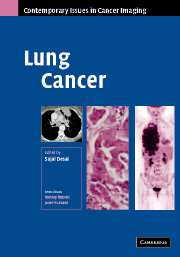Book contents
- Frontmatter
- Contents
- Contributors
- Series Foreword
- Introduction
- 1 Clinical Considerations in Lung Cancer
- 2 Pathology of Lung Cancer
- 3 Imaging of Lung Cancer
- 4 Screening for Lung Cancer
- 5 Staging of Lung Cancer
- 6 Positron Emmision Tomography in Lung Cancer
- 7 Contemporary Issues in the Systemic Treatment of Lung Cancer
- 8 Radiotherapy in Lung Cancer
- 9 Surgery for Lung Cancer
- Index
- Plate Section
- References
3 - Imaging of Lung Cancer
Published online by Cambridge University Press: 12 August 2009
- Frontmatter
- Contents
- Contributors
- Series Foreword
- Introduction
- 1 Clinical Considerations in Lung Cancer
- 2 Pathology of Lung Cancer
- 3 Imaging of Lung Cancer
- 4 Screening for Lung Cancer
- 5 Staging of Lung Cancer
- 6 Positron Emmision Tomography in Lung Cancer
- 7 Contemporary Issues in the Systemic Treatment of Lung Cancer
- 8 Radiotherapy in Lung Cancer
- 9 Surgery for Lung Cancer
- Index
- Plate Section
- References
Summary
Introduction
According to estimates of the American Cancer Society over 170,000 new cases of bronchogenic carcinoma will have been diagnosed in the United States alone during 2005. Moreover, nearly 60% of those diagnosed with lung cancer will die within one year of diagnosis rising to a staggering 75% at two years and 90% at five years. Lung cancer remains the leading cause of cancer deaths worldwide in both sexes with an estimated 163,510 deaths (90,490 in men and 73,020 in women) predicted in 2005. It is a sobering thought that no improvement in survival from lung cancer has occurred in the last 10 years.
In the following chapter the imaging features of primary bronchogenic carcinoma, principally on chest radiography and computed tomography (CT) are considered; a separate chapter has been devoted to the utility of imaging tests in the staging of lung cancer in this volume. Although the histopathological features are also covered in detail elsewhere in this volume on lung cancer, the present chapter begins with a brief discussion of the pertinent histopathological considerations.
Histopathological Classification of Lung Cancer
The most widely accepted histological classification system is that of the World Health Organisation which categorizes primary lung neoplasms into four common cell types:
Squamous Cell Carcinoma
This histological subtype accounts for 30% of all primary malignant lung tumours and it typically originates centrally.
- Type
- Chapter
- Information
- Lung Cancer , pp. 27 - 45Publisher: Cambridge University PressPrint publication year: 2006



